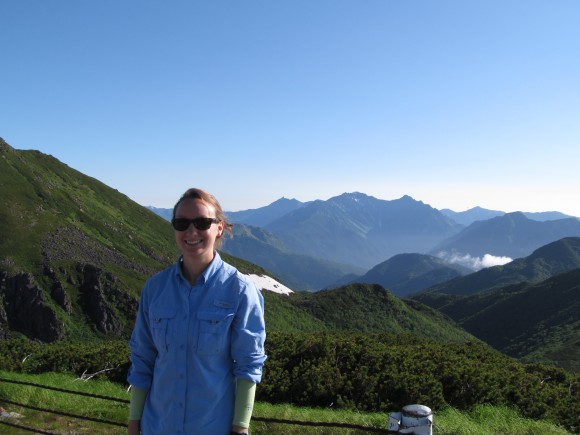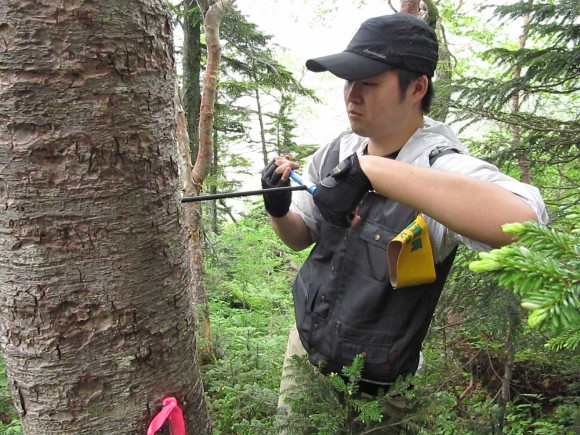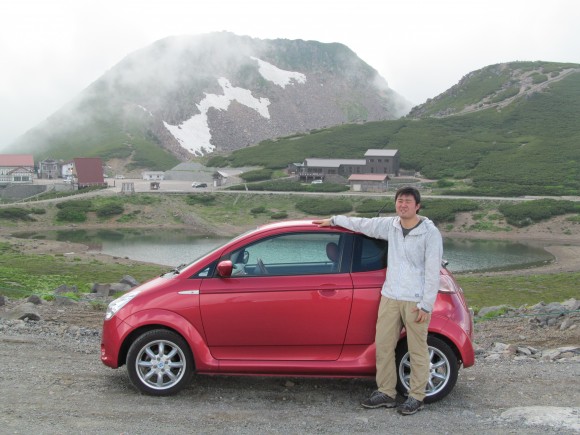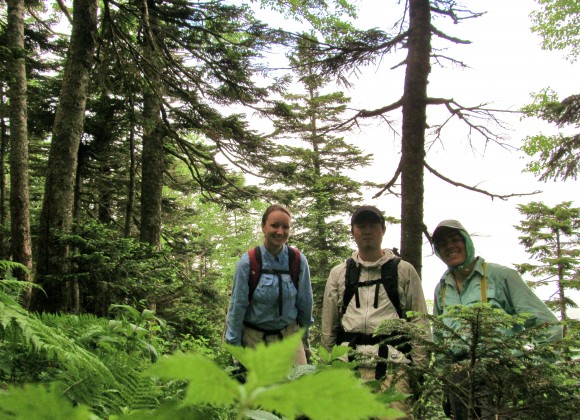I realize that many of you do not really understand what I have been up to here in Japan. You realize I am here doing research, at that research in the forest, but what am I truly up too.
I’ll give you an outline of an average day here in Japan.
I wake up around 5:30 when the light starts streaming into my room at the cottage, however, my alarm does not go off till 6:00 so I lie in bed and doze for about 30 minutes until my alarm clock actually goes off. Then I get up out of bed, fold it up for the day and get dressed in the clothes that I have been wearing everyday in the field. Before I leave my room if it is not raining I open my window so that the room stays cool through the day and then go down the hall to the dinning area to eat breakfast.

Horrible picture but it is difficult to take too many self portraits while in the shrubs. This photo is to show my ‘uniform’ for the summer. The only official thing about it is my arm band which says something of the sort of Shinshu University Research, I think it says more but I do not know what. The arm band is great, though frequently I just have it attached to my backpack. The reason it is great is because it answers many questions of people that see me out and about.
Breakfast is one of two very similar things. 1. Oatmeal or 2. Rice. The oatmeal is not quite like oatmeal in the USA but it does the job. On occasion I run out of oatmeal and then I cook extra rice at dinner for breakfast. Into this grain I add peanut butter and honey. Though I must say the peanut butter is really nothing like what we eat in the US, it is a source of morning protein. With this I drink a cup of instant Nestle coffee with lots of milk powder. I am not really that fond of the instant coffee but the caffeine is nice. Odd as it might be the Instant Nestle Coffee’s label is in Spanish with a Japanese sticker on top. Lots of western or American food here is in Spanish.
After breakfast I fill up my water bottles, make sure lunch and snacks are packed. Then I go to the drying room for my gators and measuring pole before heading for the door. At the door I put my boots and gators on. The last thing I do before I leave is say itte rasshai (So long or I’ll go and come back). Then I start my hike.
The hike to my field sites depends on where I am going, all are easily accessible. Takahashi Sensei has established 125 plots on Norikura, and he has done so with the forethought that he will not always be young and able but that he will continue to want to study and monitor the forest as he ages. Knowing this most of his plots is within easy access from either the road up Norikura or along one of the hiking trails. Most plots are within a 30 minute walk from the cabin.
If I am in a Haimatsu or Kaba forest I make sure I am wearing my long sleeves. This is a precaution not for the bugs, though my collar is normally popped to keep the large horseflies at bay, but for the branches. My arms are littered with cuts and bruises from walking through shrubs. Some mornings I do not realize it for it is hot and I have either a tee-shirt or my sleeves rolled up, but after an hour or two of bushwhacking my forearms are either bleeding or stinging from the shrubs. So, I roll them down or change shirts. You would think I would remember, but the morning hike is hot.
I have a map of all of the plots as well as their GPS coordinates, though this does not always make them easy to find. Plots are denoted by ‘number tape’ that is thick flagging with numbers typed on to it, that have been stapled to trees. Additionally, each plot is 10 x10m in size and at each corner is a piece of PVC piping. This piping is however, not always easy to find.
For my research I am using point centre quarter methods, which means that I divide each plot up into 4 quarters or segments. I put a stake (branch with flagging) in at the centre of each plot. Thus if I can find two of the four stakes I can take an azimuth and find the centre of the plot knowing the proper distance to the middle knowing the proper distance to the middle using Pythagoreans theorem. So I don’t in truth have to find all of the corners, which is really nice.

Once I establish the centre of the plot, I record the azimuth to the plot in case I need to return, so that I can find the same trees. Then I attach a measuring tape to a tent stake. In each of the quarters I measure the distance to the nearest tree greater than 2 meters tall (Kaba and Momi) or greater than 4cm at base (haimatsu). In addition to measuring the distance to the nearest tree I also record the azimuth to that tree and the distance and azimuth to its nearest neighbor. That is right trees have neighbors, they are very competitive with one another and try to interfere in each others lives.

The diameter at base and at breast height (1.37m) is measured and recorded for all trees as well as their position in the canopy. Are they dominant, co dominate, intermediate or suppressed. Additional parameters are taken from the nearest trees in each quarter such as tree height, height to lowest branches, diameter of crown at it’s widest and perpendicular to that. Lastly, a tree core is taken from each of the nearest trees that is greater than 4 cm at base.
Now I know some of you know what a tree core is but not all, so let me briefly explain. A tree core is taken from the tree by using a tree borer (insert photo). Basically, it is a hollow drill that is manually drilled into the tree. Once the centre of the tree has been reached a spoon (not a kitchen spoon, but one for this purpose) is use to extract the core from the inside of the borer. The tree core is then put into a straw and labeled and the borer is extracted from the tree.

Out of date photo of me coring a tree, this photo is from 2007 in Northern Sweden. You should be able to get the idea from the photo. If you know anything about coring trees, please disregard the technique in the photo for I had a broken collar bone at the time and was only demonstrating how to core to my undergraduate assistant.
Though when I write it out it does not seem like it should take that long plots normally take 1-2 hours a piece, sometimes more if I have difficulty in finding the plot or coring the trees or if it raining.
I work until I get hungry for lunch anytime between 10 am and 1pm, then I eat. Lunch is leftovers from dinner. Dinner is purposefully made to big so that I also have lunch. I also have rice crackers, fruit and some candy. Then back to work. I keep going until about 6-6:30 in the evening and then I pack up and head back to the cabin getting back around 6:30-7pm. Before going inside I try to shed as many fir and pine needles as well as twigs off my person, letting my hair down things always fall out.
Upon my arrival I say ‘Tadaima’, which always is a great feeling. If there are other guests at the cottage I say ‘Kobanwa’ or ‘Konichiwa’ before they start talking to me and I don’t know what they say. If that happens the cabin owner or his staff tells them to let me go put my stuff down before talking with me. They know that when I return in the evenings I am exhausted and that it takes a little bit for me to be able to communicate. Food helps. If there are no guests I just go about my own business.
I put my measuring pole and gators back into the drying room till morning, change out of my field clothes and go to the dining room. It’s dinner time, well, it’s time to cook dinner and lunch. I didn’t really know what people ate in the mountains, and as of yet at the cottage none of the other visitors have cooked their own food they have bought from the cottage. So what do I eat for two of my meals a day? Basically fried rice, but different than what we would call that from in America. I cook up rice and put a packet of beans and other grains in with it. When the rice is almost cooked I cut up some dried fish (I don’t know what kind, but it is good and smoked) and throw it in to hydrate. When the rice is done, I stir fry some veggies. Typically, bell peppers and eggplant though sometimes also carrot and zucchini. The zucchini though does not taste very good the next day so I have stopped that. When the veggies are almost done I scramble two eggs and put them in too. Once this is all cooked I mix it into the rice and add a couple of packets of flavoring. I have no clue what the flavors are but I do like some better than others. I try looking at the pictures for help in understanding. If I don’t like the flavor, I’ll add some soy sauce.

Lunch! Dinner only looks different for it is in a bowl and steaming.
That is dinner. After dinner I clean the pots with paper towels and eat a piece of fruit. By this time it is normally about 8 pm. I go back to my room and either read, enter data (not fun) or I do my favorite activity of punching holes into straws. Yeap, punching holes into straws. This is so that the cores can dry more efficiently and not mold. First I take the straws out of their plastic wrappers, then I use a hole puncher to punch holes along the straw.
At 9 pm the generator is turned off and all but emergency lights. I read with my headlamp until maybe 9:30 or 10 pm and then I pass out till morning to start the routine all over again.
 Outside the Cosmic Ray Research Station the morning of our first day of work (Amanda, Abby, Yosuke)
Outside the Cosmic Ray Research Station the morning of our first day of work (Amanda, Abby, Yosuke) Abby with the whole of the Northern Alps in the background
Abby with the whole of the Northern Alps in the background Getting the hang of coring Betula (birch)
Getting the hang of coring Betula (birch) 3026 meters is not enough for Abby, she wants to get to 3028m.
3026 meters is not enough for Abby, she wants to get to 3028m. Yosuke coring his very first tree!
Yosuke coring his very first tree! Yosuke and his car Tentoumoushi (ladybug) which he kindly shuttled us around with at our first site on Norikura.
Yosuke and his car Tentoumoushi (ladybug) which he kindly shuttled us around with at our first site on Norikura. Yosuke teaching Abby and I how to cook Japanese Curry.
Yosuke teaching Abby and I how to cook Japanese Curry.


























